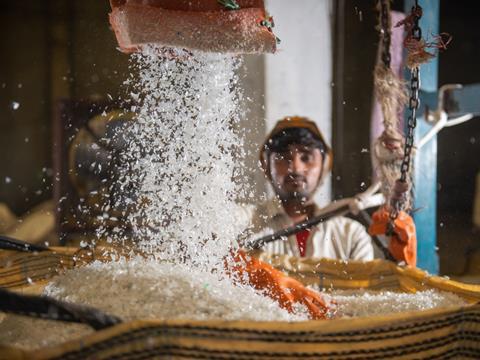
The EU’s deadline for all packaging to incorporate at least 30% recycled material is fast approaching, while the industry finds itself in the middle of what some are describing as a “post-consumer recycled materials crisis”. Jack Bigio, Co-Founder and Co-CEO of UBQ Materials, tells us more about how the packaging value chain can overcome these challenges.
Global brands are aiming, over the next three years, to increase recycled content in their packaging. Beyond brand promises, regulation is also moving in this direction. The European Union has mandated that all packaging incorporate 30% recycled material by 2030, while several U.S. states have passed laws requiring certain plastic products to contain more recycled content.
Time is of the essence if manufacturers, retailers and other companies are to reach these goals, but shortages of post-consumer recycled material feedstock, coupled with a global supply chain crisis, have made it potentially unattainable by 2025.
In the midst of a post-consumer recycled (PCR) materials desert, brands will need to address this problem with ingenuity and creativity to find new solutions.
What’s causing supply chain issues?
The demand for recyclable materials has outstripped supply for years due to the recycling system only capturing a mere 18% of plastics and packaging, along with there being too few suppliers. Additionally, the slow and costly move towards recycling paper, plastics and other materials has bottlenecked supply.
All of this has worsened over the past two-plus years. With pandemic-induced lockdowns, a combination of manufacturers shutting their doors, and unprecedented labor shortages, the global supply chain has experienced massive disruption since H1 2020. As a result, output of recyclable resins, plastics, and other materials either slowed drastically or came to a screeching halt.
Additional variables have since exacerbated an already complicated situation. Cargo ships are floating aimlessly in the water amidst an ocean-wide traffic jam, waiting to dock at ports and unload goods that have been on backorder for months or even years. A lack of port employees, crane operators and truck drivers is crippling efforts to rectify the situation.
Moreover, the ongoing war in Ukraine has slowed down the recyclable materials market considerably and has also caused increases in the prices of oil and construction materials. This, coupled with rising inflation, is adding to the costs and reducing the availability of PCR materials.
Why the shift to PCR materials is necessary
Today, most packing is derived from fossil fuels, and according to researchers, “when exploited for short-term storage packaging, these materials represent a serious environmental concern.” A separate study pointed out that “economically developed countries… are responsible for the biggest share of plastic packaging waste and have implemented the most advanced and ambiguous legislation and regulation for plastic packaging waste prevention and recycling.”
With this significant environmental threat caused by packaging pollution, manufacturers and their customers are beginning to appreciate the value of environmentally friendly materials that incorporate greater volumes of recycled materials.
Creating a materials oasis
There are companies working to find creative solutions for the PCR materials shortage. For example, shipping companies are moving towards a minimalist packaging approach, using fewer packaging materials to house shipped products.
Brands are also using a minimalist approach, stripping back flashy or distracting designs in favor of simplicity to ensure that less material is required for the packaging of consumer goods.
Paper-based packaging has also become a more sustainable answer as it can be recycled and is highly recovered. Other ideas taking the consumer market by storm include shoes made from discarded plastic bottles and scooters made from old fishing nets.
A UK-based company recently started developing roofing material and tiles from used diapers, while in the fashion and furniture industries, companies are turning to Mycelium, a fungus, to manufacture clothing and furniture upholstery.
Household waste-based materials offer another PCR feedstock option. Household waste is abundant in supply, and by converting it into usable materials for manufacturing products and packaging materials, companies can both achieve their PCR requirements, and divert waste from landfills, effectively mitigating the methane emissions which would otherwise form as a result of decomposing organic materials typical of household waste.
There are endless possibilities, but we need to turn towards creative solutions and pivot away from the chase for increasingly costly PCR materials that are in scarce supply and turn to more abundantly available options.
Closing the PCR materials gap
There is no end in sight to the global supply chain crisis, but the solution to reach the 2025 packaging goal is at our fingertips.
To adequately address the PCR materials desert, brands and manufacturers can begin taking advantage of novel PCR feedstock that is readily available. Regulatory and governmental bodies can also embrace the value of new solutions and should push for raw material substitutes that fulfill two main criteria: raw materials must be both accessible and sustainable. Such options can play a key role in closing the ever-growing gap plaguing the global supply and demand chain.

















No comments yet